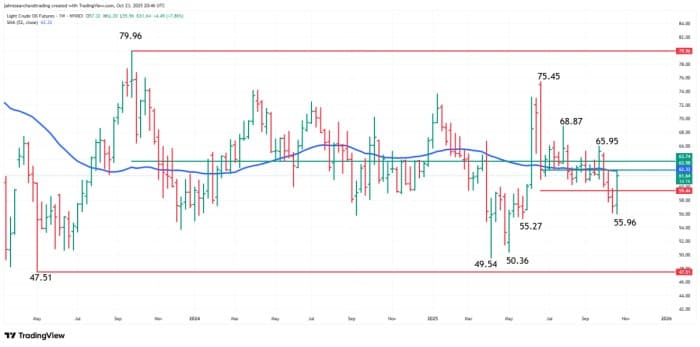Light crude oil futures surged more than 8% this week, driven by aggressive short-covering and geopolitical risk after the U.S. slapped new sanctions on Russia’s top oil exporters. However, despite the sharp rally, underlying supply and macroeconomic concerns continue to cap the upside, keeping traders cautious about the sustainability of the move.
The week began with crude trading near multi-month lows as sentiment remained firmly bearish. Concerns about oversupply, a deteriorating demand outlook, and a structurally bearish contango in the futures curve had pressured prices below $56. However, the tone shifted dramatically midweek as U.S. sanctions against Rosneft and Lukoil—Russia’s two largest oil producers—reignited geopolitical risk premiums and fueled a strong rebound.
WTI crude climbed to $61.79 by Thursday’s close, marking an $4.64 weekly gain and its strongest close since early October. The move was the largest one-day percentage increase since mid-June, underscoring the market’s sensitivity to global supply disruptions—even if driven more by policy headlines than changes in physical flows.
U.S. Sanctions Target Russian Supply Chains and Trigger Regional Disruptions
The primary catalyst behind the rally was Washington’s decision to impose sanctions on Rosneft and Lukoil, part of an effort to restrict Russia’s energy revenue amid the war in Ukraine. The move was matched by similar actions from the UK and European Union, including bans on LNG…
Light crude oil futures surged more than 8% this week, driven by aggressive short-covering and geopolitical risk after the U.S. slapped new sanctions on Russia’s top oil exporters. However, despite the sharp rally, underlying supply and macroeconomic concerns continue to cap the upside, keeping traders cautious about the sustainability of the move.
The week began with crude trading near multi-month lows as sentiment remained firmly bearish. Concerns about oversupply, a deteriorating demand outlook, and a structurally bearish contango in the futures curve had pressured prices below $56. However, the tone shifted dramatically midweek as U.S. sanctions against Rosneft and Lukoil—Russia’s two largest oil producers—reignited geopolitical risk premiums and fueled a strong rebound.
WTI crude climbed to $61.79 by Thursday’s close, marking an $4.64 weekly gain and its strongest close since early October. The move was the largest one-day percentage increase since mid-June, underscoring the market’s sensitivity to global supply disruptions—even if driven more by policy headlines than changes in physical flows.
U.S. Sanctions Target Russian Supply Chains and Trigger Regional Disruptions
The primary catalyst behind the rally was Washington’s decision to impose sanctions on Rosneft and Lukoil, part of an effort to restrict Russia’s energy revenue amid the war in Ukraine. The move was matched by similar actions from the UK and European Union, including bans on LNG imports and financial restrictions on Russian oil entities and intermediaries.
While skepticism persists regarding the long-term effectiveness of sanctions—given Russia’s history of circumventing previous restrictions—this latest package has had more immediate consequences. Key buyers in Asia, particularly India and China, are now reassessing their Russian crude exposure due to fears of secondary sanctions or exclusion from Western banking systems.
According to Reuters, Chinese state-owned oil majors have suspended purchases of seaborne Russian oil from the sanctioned firms, while Indian refiners including Reliance Industries are preparing to reduce or halt imports. Since India and China account for the bulk of Russian crude exports, any disruption in these flows would force these buyers to seek alternative supplies, tightening global availability and supporting prices for non-sanctioned grades.
OPEC Ready to Offset Gaps, but Russia’s Role Remains Pivotal
While the sanctions may boost prices in the near term, their lasting impact depends heavily on Russia’s ability to find alternative markets for its oil. Russian President Vladimir Putin acknowledged the challenge, stating that replacing Russian crude in the global system will “take time.”
At the same time, Kuwait’s oil minister confirmed OPEC’s readiness to roll back production cuts if the market shows signs of a real shortage. This conditional backstop from OPEC provides a stabilizing signal but does not yet indicate an imminent policy shift. Most OPEC+ members are likely to monitor the sanctions’ fallout before adjusting volumes, especially if shortfalls from Russia remain speculative.
Western pressure on Asian importers continues to mount, and traders are monitoring how compliance develops ahead of the U.S. Treasury’s November 21 deadline to unwind Russian oil transactions. Until then, Russian supply flows will remain under scrutiny, potentially keeping volatility elevated.
Inventory Trends and Trade Talks Add Complexity to Outlook
U.S. Energy Information Administration (EIA) data this week added another bullish layer, showing surprise draws in crude, gasoline, and distillate inventories. Combined with strengthening refinery activity and domestic fuel demand, the report helped reinforce the notion that physical tightness in the U.S. may be more pronounced than previously assumed.
Additionally, optimism surrounding renewed U.S.-India trade negotiations added fundamental support. India is reportedly considering cuts to Russian crude imports as part of a potential deal to ease U.S. tariffs on its exports. If such a deal materializes, it could not only redirect Indian buying toward more transparent markets but also remove a major hurdle in Washington’s push to isolate Russian oil.
Uncertainty remains over U.S.-China trade relations. While President Trump hinted at progress ahead of upcoming talks in Malaysia, he later cast doubt on the timing. Any breakthrough on this front could provide fresh demand-side support, but for now, traders are more focused on supply developments.
Weekly Light Crude Oil Futures

Trend Indicator Analysis
Light crude oil futures extended their four-week decline but found strong support at $55.96, just above the May low of $55.27. The early buying sparked a sharp rebound on the weekly chart, setting the stage for a potential bullish closing price reversal bottom.
Looking ahead, key resistance levels will determine whether this rebound gains traction. On the upside, the first resistance is the 52-week moving average at $62.32. This is followed closely by a minor pivot at $62.50. The major resistance and potential trigger point for an acceleration to the upside is the long-term 50% level at $63.74.
Overtaking the 52-week moving average will be a sign of strength and a shift in momentum, but a sustained move over the 50% level at $63.74 could launch a spike into a former top at $65.95, followed by $68.87.
If buyers fail to overcome the 52-week moving average then look for prices to retreat into Fibonacci support at $59.44, followed by $55.96 to $55.27.
As far as our trend indicator is concerned, we’re going to go with the 52-week moving average. The market remains below the 52-week moving average, keeping the short-term trend bearish as we approach Friday’s open.
Weekly Technical Forecast
The direction of the Weekly Light Crude Oil Futures market the week ending October 31 is likely to be determined by trader reaction to the 52-week moving average at $62.32.
Bullish Scenario
Recovering and sustaining a move over the 52-week moving average will signal the return of buyers. This will shift momentum higher and set up a possible breakout over $63.74.
Bearish Scenario
A sustained move under the 52-week moving average will indicate the presence of sellers. This could trigger a retracement of this week’s short-covering rally with $59.44 the first target, followed by the support zone at $55.96 to $55.27.
Oil Prices Forecast: Bullish in the Short Term, Cautious Beyond
The sharp reversal in crude oil prices has reintroduced bullish sentiment, but the sustainability of the rally depends on how sanctions compliance unfolds, especially from India and China. If Russian barrels are successfully redirected, the price rally could lose steam. However, if sanctions materially disrupt global flows—particularly in Asia—the market could shift into a deficit sooner than expected.
For now, the oil prices forecast holds a short-term bullish bias, driven by geopolitical risk, shrinking Russian exports, and bullish inventory data. However, traders remain wary of re-entering long positions too aggressively given the underlying macroeconomic uncertainty and the persistent risk of a return to oversupply if demand falters.
Crude’s next move hinges on actual shifts in trade flows—not just headlines. Until then, volatility will likely remain elevated, with traders positioned for both policy shocks and potential supply rebalances.
The market’s response to the 52-week moving average at $62.32 will likely determine whether bullish momentum can extend or stalls at resistance.


